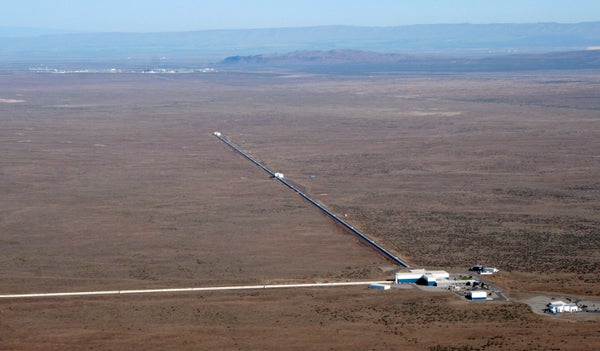In physics circles a sense of déjà vu is setting in—breathless headlines have recently championed a possible discovery of gravitational waves, or ripples in the fabric of spacetime. Less than a year ago the same thing happened, although that time the team behind the Background Imaging of Cosmic Extragalactic Polarization 2 (BICEP2) experiment claimed a discovery that turned out to be a mistake. Time will tell if the new potential detection, about which rumors have swirled in lieu of any official announcement by the Laser Interferometer Gravitational-Wave Observatory (LIGO), will turn out to be real. If it is, though, we are talking about a different kind of gravitational wave with very different implications for our understanding of the universe.
LIGO searches for powerful gravitational waves created by some of the most violent events in the cosmos, such as collisions between black holes or dense objects called neutron stars. “They’re looking for the most cataclysmic events you could imagine happening in our galaxy or nearby galaxies,” says Lawrence Krauss, a physicist at Arizona State University in Tempe who is not involved in the experiment and tweeted about his excitement over the rumors. “The mass is so great in such a small area that the gravitational fields are strong enough that most of the energy of the collision would be emitted in the form of gravitational waves.”
Gravitational waves are a prediction of Albert Einstein’s general relativity, which explained that gravity results from a curvature in spacetime. Whenever mass moves through space it warps the geometry of the universe around it, causing other nearby traveling masses to move along curving paths. “Every time I move my arms my body is changing the curvature of space around me, which produces a ripple in spacetime,” Krauss says. “It’s just that those gravitational waves are so small” they are imperceptible. LIGO uses detectors in Louisiana and Washington State to search for tiny differences in the time it takes light to travel down perpendicular pathways. The pathways are the same length but if a gravitational wave passed by, it would stretch spacetime in one direction, causing only one of the two pathways to expand and thus inducing a minute difference in the travel time for the light. “They have to measure a path difference smaller than one one-hundredth of a proton,” Krauss says. “It’s amazing they can do that.”
On supporting science journalism
If you're enjoying this article, consider supporting our award-winning journalism by subscribing. By purchasing a subscription you are helping to ensure the future of impactful stories about the discoveries and ideas shaping our world today.
The gravitational waves LIGO is looking for are thought to arise every so often in the modern universe around us. BICEP2, on the other hand, targets primordial gravitational waves born in the very early universe. Based at the South Pole, BICEP2 studies the cosmic microwave background (CMB) light released just some 380,000 years after the big bang and looks not for the waves themselves but for a signature they might have left in the light. The telescope is searching for imprints in the CMB of gravitational waves that might have been created if the universe ballooned rapidly in size immediately after its birth, as predicted by a theory called inflation. According to inflation, tiny random quantum fluctuations in spacetime would have stretched along with the universe, producing gravitational waves that would have left polarization—that is, a special orientation of the light waves—in the CMB. In April 2015 the team announced, to much fanfare, that they had discovered this polarization. But later studies revealed that what they saw is most likely contamination from nearby dust in our galaxy.
BICEP2 and other experiments like it are still searching for evidence of primordial gravitational waves but would not be sensitive to modern waves such as LIGO is seeking, which in turn would not affect the CMB. And LIGO, for its part, probably cannot see those ancient gravitational waves because their signal in the wavelength band it targets “is much smaller than the current detector noise,”—that is, minor background interference—“so this is not a likely source to be detected,” says Louisiana State University astrophysicist Gabriela González, spokesperson of the LIGO Scientific Collaboration. (And both types of gravitational waves are different from “gravity waves,” a term from fluid dynamics that refers to ripples in a liquid exposed to a material of a different density, such as waves on the ocean where the water meets the air.)
A discovery of either primordial or contemporary gravitational waves would be a major breakthrough, but for different reasons. “The gravitational waves that BICEP2 was trying to detect would have been a signal from the very early universe,” says Marc Kamionkowski, an astrophysicist at Johns Hopkins University who predicted in 1997 how primordial gravitational wave imprints could be found. The discovery would have offered proof for inflation theory and could have revealed details about how the first moments of cosmic history played out. LIGO’s gravitational waves, if they are real, would probe how gravity works in extreme objects such as neutron stars and black holes, where current physics theories break down. And whereas BICEP2 seeks imprints on the CMB light created by gravitational waves, LIGO is aiming to directly detect the waves themselves, which would be a first. “It’s been 100 years and two months since Einstein proposed his theory of general relativity,” Kamionkowski says. “It would be absolutely remarkable if this was then confirmed after 100 years of searching. To me, that’s a big deal.”
